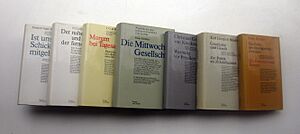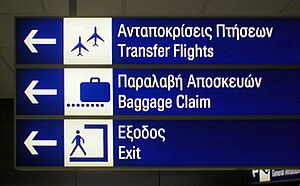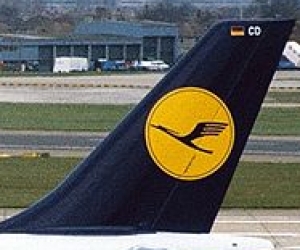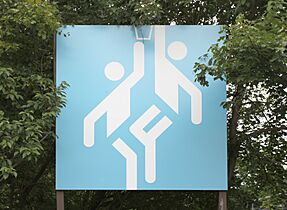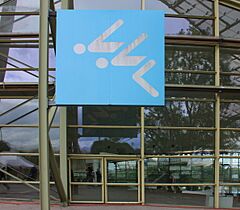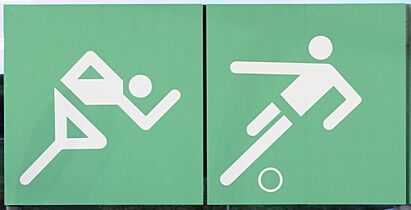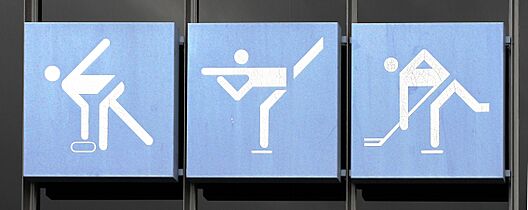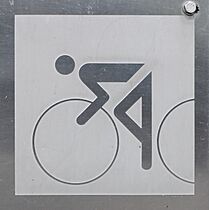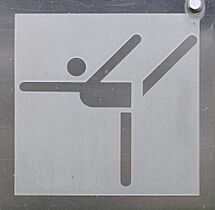Otl Aicher facts for kids
Quick facts for kids
Otl Aicher
|
|
|---|---|
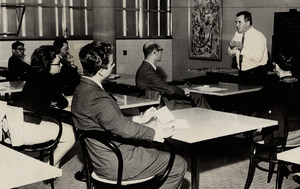
Aicher (right, in 1959)
|
|
| Born |
Otto Aicher
13 May 1922 |
| Died | 1 September 1991 (aged 69) Günzburg, Germany
|
| Nationality | German |
| Alma mater | Academy of Fine Arts Munich |
| Occupation | Graphic designer, typographer |
| Spouse(s) |
Inge Scholl
(m. 1952) |
| Relatives | Robert Scholl (father-in-law) Sophie Scholl (sister-in-law) Hans Scholl (brother-in-law) |
Otto "Otl" Aicher (born May 13, 1922 – died September 1, 1991) was a famous German graphic designer and typographer. A graphic designer creates visual things like logos and posters. A typographer designs typefaces, which are sets of letters and numbers (like fonts). Otl Aicher helped start the important Ulm School of Design in Germany. He is best known for leading the design team for the 1972 Summer Olympics in Munich. He created the easy-to-understand pictograms used at the Games. Aicher also designed the Rotis typeface.
Contents
Aicher's Early Life and Resistance
Otl Aicher was born in Ulm, Germany, on May 13, 1922. He was a close friend of Werner Scholl. Through Werner, he met his siblings, Hans Scholl and Sophie Scholl. Hans and Sophie were part of a brave group called the White Rose. This group secretly resisted the Nazi government during World War II.
Like the Scholls, Aicher strongly disagreed with the Nazis. In 1937, he was arrested because he refused to join the Hitler Youth. This was a youth group that supported the Nazi party. Because of his refusal, he failed his college entrance exam in 1941. He was later forced to join the German army during World War II. In 1945, he left the army without permission and hid at the Scholls' house.
After the war ended in 1945, Aicher began studying sculpture in Munich. In 1947, he opened his own design studio in Ulm. In 1952, he married Inge Scholl, who was the older sister of Werner, Hans, and Sophie.
The Ulm School of Design
In 1953, Otl Aicher, along with his wife Inge Scholl and designer Max Bill, started the Ulm School of Design. This school became one of Germany's top places to learn about design. It was open until 1968. Many famous designers taught or studied there.
Aicher was very good at creating a unique look for companies. This is called Corporate design. He helped design the look for companies like Braun. He also designed the well-known logo for the German airline Lufthansa in 1969.
Designing the 1972 Munich Olympics
In 1966, the people organizing the 1972 Summer Olympics in Munich asked Aicher to be the main designer. They wanted him to create a design style that matched the new stadium in Munich. Aicher talked with Masaru Katsumie, who had designed the previous 1964 Tokyo Olympic Games.
Creating Clear Pictograms
Aicher created a set of pictograms for the Munich Games. Pictograms are simple pictures that represent something, like a sport or a place. His goal was to help athletes and visitors find their way around the Olympic village and stadium easily. He based some of his ideas on the pictograms from the 1964 Games.
Aicher designed his pictograms using a special grid system. He also chose a bright color palette for the Games. These designs were so good that they influenced the DOT pictograms. These were developed in 1974 for public signs like those for toilets and telephones. Aicher's pictograms needed to be clear and understood by everyone, no matter what language they spoke.
The Olympic Logo and Colors
Otl Aicher also helped design the logo for the Munich Olympics. His team tried many ideas. One idea was to use a symbol from the city's coat of arms. Another idea was to use images of the sun, mountains, and landscape around Munich.
Finally, they created the "Strahlenkranz" (garland of rays). This design looked like the sun and also had the five Olympic rings blended into a spiral shape. Another designer, Coordt von Mannstein, helped perfect the final logo.
The colors chosen for the Games were inspired by the Alps mountains. Blue and white were key colors, along with green, orange, and silver. These colors helped identify different areas, like media services or public functions. Olympic staff uniforms were also color-coded. This way, visitors could easily tell which department a staff member worked for.
Posters and the First Mascot
Aicher used the Univers typeface for all the Olympic designs. His team made 21 sports posters to advertise the Games. These posters used the official colors and included the logo and "München 1972." The team used a technique called "posterization" to create the graphics. This made the images look bold and colorful. The first poster, showing the Olympic stadium, became the official poster for the Games.
These posters were displayed all over Munich. They were often hung next to posters designed by famous artists like David Hockney. Aicher also created the first official Olympic Mascot, a striped dachshund dog named Waldi.
- Aicher's pictograms at the 1972 Munich Olympics
Later Work and Legacy
In 1980, Otl Aicher became a consultant for the kitchen company Bulthaup. He designed the Rotis font family in 1988. He named it after the place where he lived and had his design studio, near the town of Leutkirch im Allgäu. The Rotis typeface is still used by Bulthaup today.
Aicher also designed logos for other places, such as the University of Konstanz and the Munich Airport.
Death and Recognition
Otl Aicher died on September 1, 1991, in Günzburg. He was hit by a motorbike while mowing grass at his home in Rotis.
The city of Munich honored Aicher on May 6, 2010. They named a street, Otl-Aicher-Straße, after him. A school in Leutkirch im Allgäu also carries his name.
See also
 In Spanish: Otl Aicher para niños
In Spanish: Otl Aicher para niños


